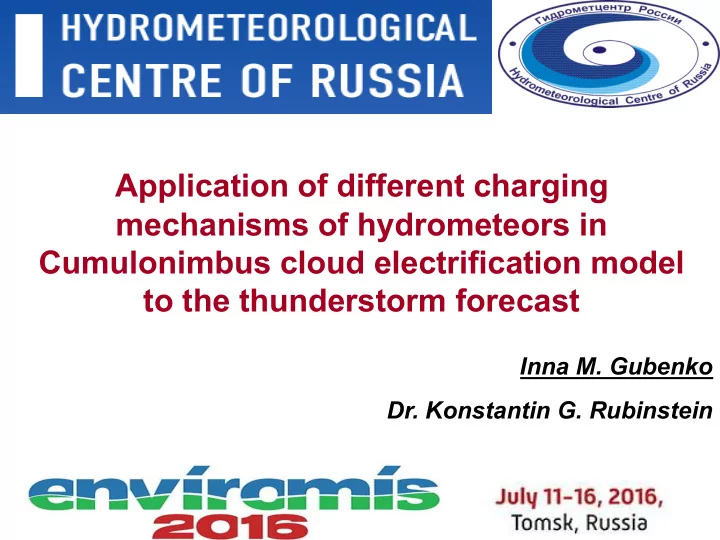

Application of different charging mechanisms of hydrometeors in Сumulonimbus cloud electrification model to the thunderstorm forecast Inna M. Gubenko Dr. Konstantin G. Rubinstein 1
MAIN ISSUE & OBJECTIVES MAIN ISSUE Cumulonimbus (Сb) electrification model which uses the forecasts of numerical predictive mesoscale model WRF- ARW (Weather Research and Forecast) and allows to predict the parameters of the atmospheric electric field (total volume charge, potential and electric field intensity) including specific to thunderstorm activity. MAIN OBJECTIVES Ø Physical and mathematical description of the electrification model. Ø Analysis of simulated parameters of the atmospheric electric field for the cases when the simulated thunderstorm Ø cells coincide with observed thunderstorm cells. Ø Comparison of the prognostic values of electrical 2 https://i.ytimg.com/vi/EAHbMk015Rw/hqdefault.jpg breakdown with the thunderstorm observations.
Cumulonimbus cloud Electrification model Input data: Charging processes: • Vertical profiles of meteorological variables 1. Gravitational speeds computed by WRF-ARW 2. Turbulent coagulation • Constants 3. Charge produced in one collision 4. Inductive, non- inductive & integrated charging between interacted solid hydrometeors Lightning parameterization 1. Volume charge 2. Electric potential 3. Electric field intensity
CHARGE STRUCTURE IN A SIMULATED THUNDERCLOUD Fig 1. Charge structure in the simulated Cb by the electrification model based on three charge generation schemes during thunderstorms over Central Federal District of Russia for summer, 2013: (a) average vertical profile of the electric field intensity, kV/m; (b) average vertical profile of the total volume charge, nC/m 3
VALIDATION: PERIOD & DISTRICT OF STUDY
CONCLUSIONS AND ACKNOWLEDGMENTS Ø The effect of non-inductive charging makes a significant contribution to the process of initiation of lightning discharges. Ø The accuracy of the thunderstorm forecast given by the electrification model based on the non-inductive charge generation scheme showed the best results. Ø The profiles of the electric field intensity and space charge density obtained by the electrification model have a structure with predominance of positive charge at the top of the cloud, negative - in the middle and positive - in the bottom of Cb. This work was supported by the RFBR (Russian Foundation for Basic Research) under grants А 14-08-01105, А 15-05-02395 and A 16-05-00822.
THANK YOU! 7
Recommend
More recommend